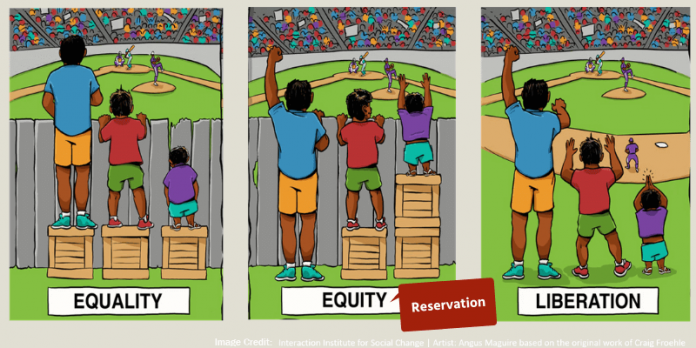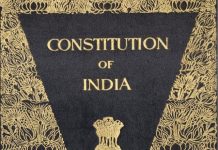This article is written by Paridhi Goel, a B.A LLB student from Symbiosis Law School. This is an exhaustive article which deals with the analysis of the case Jarnail Singh vs. Lacchmi Narain Gupta, exploring the requirements of SC/ST getting promotions in government jobs and the creamy layer filter.
Table of Contents
Introduction
The Supreme Court delivered its verdict on 26th September 2018 in the case of Jarnail Singh vs. Lachhmi Narain Gupta– which is also known as the ‘Reservation in Promotion Case’. A five-judge bench which consisted of Former Chief Justice of India Dipak Misra, Justice Kurian Joseph, Justice RF Nariman And Justice SK Kaul and Justice Indu Malhotra, reviewed the judgment of a previous case dealing with the reservation for the Scheduled Castes and Scheduled Tribes in promotions to Government jobs or public services. This case also looked into the application of the creamy layer among the Scheduled Castes and Scheduled Tribes when applying for reservation in promotions. This aspect of the case is important because the ‘creamy layer’ is an economic criterion based on the assumption that a person is liberated from his or her backwardness due to his or her economic progress which leads to social advancements. With this social and economic standard of the creamy layer, many people preview it as caste discrimination in institutions.
Reservation has always been a controversial topic in India. Its foundation started after the Poona Pact when Doctor B.R. Ambedkar demanded separate electorates for the Dalit community. The then described “depressed classes” were given reservation in employment with joint electorates. Gradually, it was observed that the scheduled castes and the scheduled tribes or even the backward classes are given reservation, not because of their poverty, but because they are excluded mostly everywhere. Based on this, it was decided that they should be able to represent themselves in Government jobs and public services or local bodies which is why they were granted reservations in these jobs. Since the problem of exclusion still continued as they did get the job through reservation however, they were not favoured for promotions. Reservation in promotions was introduced for the Scheduled Castes and the Scheduled Tribes subject to certain conditions until the need was felt to review these conditions. This case highlights the decision of the judiciary in this regard.

Background facts
A decision was made in the M. Nagraj and Others vs. Union of India and Others in 2006 which was challenged by various states and the Centre. It was the petitioner’s view that the Nagraj Judgement had made it unjustly difficult to grant reservations in promotion for government jobs and public services. With this view, it felt necessary to analyze the conditions established in the Nagraj case and refer it to a seven-judge bench. Reservation is seen as a serious topic in India. The constitution laid down Article 16 providing for Equality of opportunity in matters of public employment and this provision originally did not contain anything related to the reservation until the Indra Sawhney case of 1992. Few observations were made in this case starting with Article 16 (4) which allows the state to make provisions for reservation of any backward class of citizens in appointments or posts but this did not apply to the promotions. This clearly affected the Scheduled Castes and the Scheduled tribes and in order to continue the promotions, Clause 4A was introduced saying that nothing in the mentioned article shall prevent the State from making any reservation in matters related to the promotion. Through the 81st Amendment, Articles 16(4A) and 16(4B) were added.
The constitutional validity of these provisions was challenged in the Nagraj Case and delivered by a five-judge bench was a verdict stating that if the State wanted to make a provision for reservation in promotions for the Scheduled Castes and Scheduled Tribes then it will have to collect ‘quantifiable data’ enough to show the backwardness of the class and inadequacy of representation of that class in public employment. The state also has to see that it’s reservation provision does not, in any case, breach the ceiling limit of 50 per cent or even wipe out the creamy layer. Since the need to collect quantifiable data to show backwardness is in contradiction to the Indira Sawhney case, it was seen as unconstitutional. Even the application of the creamy layer to Scheduled castes and tribes seemed off because it was only restricted to the other backward classes. Introducing the concept of the creamy layer to promotions also raised questions on equality. Finally, a petition was filed to review the Nagraj verdict.
Issues
- Whether the Nagraj Judgement needed reconsideration by a seven-judge bench.
- The second issue questioned whether the States had to collect quantifiable data to prove the backwardness and inadequacy of the class while being promoted.
- The third issue was whether the creamy layer among the scheduled castes and the scheduled tribes should be barred from obtaining promotions through the reservation.
Arguments
- The Supreme Court refused to reconsider the Nagraj judgment by a seven-judge bench instead the verdict was reviewed by a five-judge bench in the present case of Jarnail Singh. It did not feel the need for a larger bench to review the provisions of the Nagraj case.
- The Nagraj Verdict stated that the States in order to make a provision with regard to the promotion of scheduled castes and scheduled tribes in jobs and posts through reservation needed to collect quantifiable data to prove that they were inadequately represented in the public services. The Attorney General KK Venugopal argued that the constitution of India had already mentioned that the scheduled castes and the scheduled tribes were ‘backwards’ in nature that is socially and economically excluded. A clear definition is laid down to distinguish the Scheduled castes and Scheduled tribes from the other classes. This means that there are no further tests that can be imposed to verify the backwardness and inadequacy of their class. Those who were in favour of collecting quantifiable data pointed out that the people can go to large extents when it comes to getting a promotion and thus, a check on the backwardness of a person was only the right thing to do. Moreover, it did not harm the integrity of any person or caused any loss instead it worked as a double-check. Also, they saw the collection of data as a responsibility of the government removing which, will prove that the government only wanted to lessen their own burdens. Justice Nariman pointed out that the Indra Sawhney case does not allow for the collection of quantifiable data as a prerequisite in granting promotions through reservation and the Nagraj verdict contradicts the decision of a nine-judge bench.
- The court in the case of Jarnail Singh read the concept of the creamy layer as a part of the equality principle under Article 14, 15 and 16. Regarding this equality, some arguments were made that firstly included the true nature of a class to be backward was to exclude the socially and economically advanced individuals from the class of backward. Secondly, it was seen that exclusion of the creamy layer was necessary to make sure that the truly backward within the class can have access to reservations and that the individuals of the creamy layer do not corner all the benefits of reservation. Thirdly, if the creamy layer is not excluded then it will violate the principles of equality as it will treat the equals differently like the general classes and those who are forward among the scheduled castes and scheduled tribes and it will treat the unequals in the same manner like the backward classes and the forward among the backward classes.
- Justice Nariman observed that the whole purpose of reservation is to give a chance to the backward classes to move forward so they can be on an equal basis with the other citizens of India. If the individuals of the creamy layer are included in this reservation then the backward classes will remain as backward as they were as they will likely not get many opportunities in front of the advanced backward layer of people. He also pointed out that those people who do not form a part of the backward classes because they are categorized under the creamy layer are excluded from the benefits of reservation.
- Another argument came up based on the assumption that the principle of creamy layer is applied to the Scheduled castes and the Scheduled tribes is a big risk that the court is willing to take. It is important to understand the differences between the other backward classes and the Scheduled Castes and Scheduled Tribes. These aspects cannot be ignored by a constitutional court and it has to keep in mind that Equality is a fundamental right that needs to be safeguarded at all costs.
- Those in favour of the inclusion of creamy layer argue that the truly backward will be able to avail the benefits of the reservation in promotions even after including the creamy layer because in case of promotions, at a certain level of employment all the Scheduled castes and Scheduled tribes fall in the same economic bracket. Thus, the argument of violation of equality only works at the entry levels and not at promotions. Excluding the creamy layer might only be beneficial for the general classes. Since India has a history of discrimination at the workplace where they do not consider the Scheduled castes and Scheduled tribes as meritorious, including all the backward classes even from the creamy layer, can give a chance to prove their merit in front of the general classes.
Judgment
The court concluded that the judgment in the Nagraj case does not need to be referred to a seven-Judge bench. Along with this, the provision that the State has to collect quantifiable data showing backwardness of the Scheduled Castes and the Scheduled Tribes is contrary to the nine-Judge Bench in Indra Sawhney case making this provision invalid. It was also seen in the Indra Sawhney Case that any discussion on the ‘creamy layer’ has no relevance in the context of Scheduled castes and Scheduled tribes. Further, the Supreme Court confirmed the Application of creamy layer to promotions for Scheduled castes and Scheduled tribes as held in the Nagraj Judgement. It had resulted in thousands of employees being denied their due promotions. The court viewed the principle of the creamy layer as a principle of identification and not of equality.
Conclusion
India had a disturbing history of caste and class-based discrimination. The backward classes, the Scheduled castes, and Scheduled tribes, the untouchables all were ill-treated and were denied opportunities in every field of whether it was work or education. They required reservations not as a welfare measure but as a right of representation, a right that had been denied to them for many years. The circumstances did not change by giving them reservation in government jobs and posts as they still face discrimination and could never achieve a high rank no matter what their merit was. A reservation in promotion was a major step taken by the judiciary as not everyone was in favour of this reservation. It is commendable that our government safeguards the interests of the less privileged classes and that our Judiciary is strong enough to make the right decisions after facing a lot of criticism. Even the Judiciary is not perfect but as seen through this case, it kept reviewing cases and amending laws so that the people of our country can get what they each deserve.
References
- https://www.scobserver.in/the-desk/reservation-in-promotion?slug=article-16-4a-77th-amendment
- https://indiankanoon.org/doc/190772988/
- https://indiankanoon.org/doc/102852/
LawSikho has created a telegram group for exchanging legal knowledge, referrals and various opportunities. You can click on this link and join:











